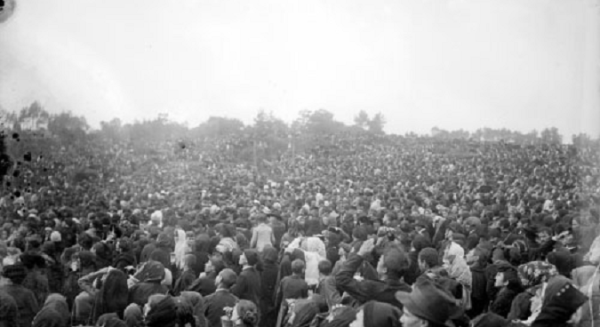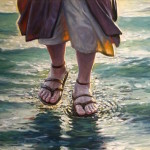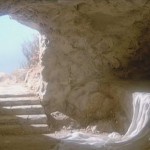Skeptic Benjamin Radford on the Fátima Miracle
by Dr. Stacy Trasancos
Filed under The Existence of God
Paranormal investigator Benjamin Radford has written a piece for Live Science on the The Lady of Fátima & the Miracle of the Sun. Mr. Radford is the deputy editor of Skeptical Inquirer science magazine and a Research Fellow with the non-profit educational organization the Committee for Skeptical Inquiry. Mr. Radford answers the question:
What really happened at Fátima?
On October 13, 1917, between 30,000 to 100,000 people gathered near Fátima, Portugal at the behest of three young shepherd children. The children claimed to have seen visions of Mary, the Mother of Jesus, and they also claimed that at high noon the "lady" would perform a great miracle in a field near Fátima called Cova da Iria, so that "all may believe." According to many witnesses, it started raining shortly before noon and then dark clouds rolled in. But then suddenly an opaque, spinning disc appeared in the sky, which many witnesses described as a "dancing sun." This took place right at the predicted time. Some witnesses also reported that their previously wet clothes became "suddenly and completely dry." Several newspaper reporters were in attendance and they took testimony from many people who claimed to have witnessed the extraordinary solar activity.
Now, Radford gives what he calls a scientific explanation for this apparent miracle. According to him, it was “an optical illusion caused by thousands of people looking up at the sky, hoping, expecting, and even praying for some sign from God.”
After a gracious reminder on the danger of damaging eyes by staring at the sun too long, he asserts that those gathered at Fátima on October 13, 1917 looked at the sun so long that they experienced an illusion of solar movement because their eye muscles got tired. He explains that these folks weren’t pulling a hoax, it’s just that they experienced something in the mind, not in the real world. He attributes the sustained belief in the miracle to the “power of suggestion” among the masses.
So what about the Fátima miracle then?
I am not an expert on all details of the Fátima phenomenon, but I’m expert enough to know that many opinions exist, a vastly large number beyond what Mr. Radford’s article covers. He summarily dismisses them though. How does he know it can all be ascribed to illusion? How does he even know what people actually saw? What if something did happen in the sky that day? Plenty of other scholars certainly think it possible. After all, there were also people there that day who played the role of dispassionate observers and also reported seeing the sun move. They weren’t all praying for a sign from God.
The biggest problem, though, is that his scientific explanation is unscientific, and unscientifically derived. It could have been a sun spot, an air lens, some turbulent clouds, or maybe even eye tricks. But how did he arrive at the certainty that it was an optical illusion on a mass scale?
In contrast, the late Fr. Stanley L. Jaki, the Benedictine priest, physicist, and historian had a little more to say. He wrote a book about this event, God and the Sun at Fátima, and he spent over a year intensely focused on researching this question, reading some sixty books and articles on the event, browsing the actual Fátima archives in two visits to Portugal, and interviewing other historians. Surprising even to him, the book project turned into a nearly 400 page account. His thesis is that there may be some sort of physical, scientific explanation, but he still holds that the event was a miracle.
Why was it a miracle?
Well, first we have to define miracle. According to St. Thomas Aquinas a miracle in the strict sense is “something done outside the order of the entire created universe.” According to Jaki, with whom I agree, the fact that the event occurred is the miracle. Even if the behavior of the sun was a purely natural phenomenon, the event in totality put this event in a class all its own. How did it come to be that a child knew when to tell the multitudes that gathered to look up for a sign from Heaven at just the right moment? Was the cause outside the order of the entire created universe?
That's not an unreasonable question to ask. In fact, it's a necessary one.
So, Radford may be right in asserting that there is a scientific explanation for what happened with the sun that day, but he didn’t even explore all of those possibilities, instead dismissing the whole thing, way too conveniently, as a mass mind trick, a conclusion that is not only unproven, but unprovable. How would you prove that tens of thousands of people were all simultaneously delusional?
On a bigger note…
An open-minded skeptic and systematic thinker must first grapple with the question of whether miracles are indeed possible or not, and demonstrate the truth of their non-existence before concluding that they do not exist. One challenge I'd propose to atheist commenters here at Strange Notions is to defend this belief. Reports of miracles are not rare among Catholics, and thousands have been confirmed by genuine investigation (ergo the title “Devil’s Advocate"). Dismissing them all as mental illusion perpetrated by the power of perception is a stretch, but even worse, if the mind plays tricks on us that much, then on those grounds we can call all our knowledge into question—including science itself.
(If you'd like to learn more about the Fátima Miracle, I'd highly recommend The Sun’s Miracle, or of Something Else?, a summary booklet Fr. Jaki wrote to explain why he investigated this question and what his general conclusions were.)
Related Posts
Note: Our goal is to cultivate serious and respectful dialogue. While it's OK to disagree—even encouraged!—any snarky, offensive, or off-topic comments will be deleted. Before commenting please read the Commenting Rules and Tips. If you're having trouble commenting, read the Commenting Instructions.













